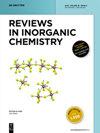Catalytic oxidation degradation of volatile organic compounds (VOCs) – a review
IF 3.1
3区 化学
Q1 CHEMISTRY, INORGANIC & NUCLEAR
引用次数: 1
Abstract
Abstract Volatile organic compounds (VOCs) are considered one of the significant contributors to air pollution because they are toxic, difficult to remove, come from a wide range of sources, and can easily cause damage to the environment and human health. There is an urgent need for effective means to reduce their emissions. The current treatment technologies for VOCs include catalytic oxidation, adsorption, condensation, and recovery. Catalytic oxidation technology stands out among the others thanks to its high catalytic efficiency, low energy requirement, and lack of secondary pollution. The difficulty of this technology lies in the development of efficient catalysts. The research on loaded noble metal catalysts and non-noble metal oxide catalysts in this area over the past few years is briefly described in this work. Firstly, the catalytic destruction mechanism of organic volatile compounds is introduced. Secondly, the effects of structural modulation during catalytic oxidation, such as the adjustment of noble metal particle size and morphology, metal doping, and defect engineering, on the conformational relationships are discussed. Finally, the challenges faced by thermal catalytic oxidation for the degradation of VOCs are discussed, and the prospects for its development are presented.挥发性有机化合物(VOCs)的催化氧化降解研究进展
摘要挥发性有机化合物(VOCs)被认为是造成空气污染的重要因素之一,因为它们有毒,难以去除,来源广泛,容易对环境和人类健康造成损害。迫切需要有效的手段来减少它们的排放。目前VOCs的处理技术包括催化氧化、吸附、冷凝和回收。催化氧化技术因其催化效率高、能耗低、无二次污染而脱颖而出。这项技术的难点在于开发高效的催化剂。本文简要介绍了近年来负载型贵金属催化剂和非贵金属氧化物催化剂在该领域的研究进展。首先介绍了有机挥发性化合物的催化破坏机理。其次,讨论了催化氧化过程中的结构调节,如贵金属颗粒大小和形态的调整、金属掺杂和缺陷工程,对构象关系的影响。最后,讨论了热催化氧化降解挥发性有机物所面临的挑战,并对其发展前景进行了展望。
本文章由计算机程序翻译,如有差异,请以英文原文为准。
求助全文
约1分钟内获得全文
求助全文
来源期刊

Reviews in Inorganic Chemistry
化学-分析化学
CiteScore
7.30
自引率
4.90%
发文量
20
审稿时长
1 months
期刊介绍:
Reviews in Inorganic Chemistry (REVIC) is a quarterly, peer-reviewed journal that focuses on developments in inorganic chemistry. Technical reviews offer detailed synthesis protocols, reviews of methodology and descriptions of apparatus. Topics are treated from a synthetic, theoretical, or analytical perspective. The editors and the publisher are committed to high quality standards and rapid handling of the review and publication process. The journal publishes all aspects of solid-state, molecular and surface chemistry. Topics may be treated from a synthetic, theoretical, or analytical perspective. The editors and the publisher are commited to high quality standards and rapid handling of the review and publication process.
Topics:
-Main group chemistry-
Transition metal chemistry-
Coordination chemistry-
Organometallic chemistry-
Catalysis-
Bioinorganic chemistry-
Supramolecular chemistry-
Ionic liquids
 求助内容:
求助内容: 应助结果提醒方式:
应助结果提醒方式:


